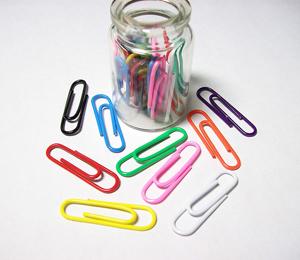London museum immortalizes invention of paper clips, condoms
Paper clips are just one of the ubiquitous items that are immortalized in London’s Science Museum. (Photo by Hawyih via Wikimedia Commons.)
Their inventors probably never thought these particular gadgets would be keeping company with rocket ships, trains and computers, but here they are, displayed as the stars they really are in London’s Science Museum.
“So this is the humble paper clip here and its origins date back to the late 19th century,” said the museum’s Nicola Ryan.
Yes, that’s right – paper clips. They are one of 36 items chosen for the Hidden Heroes exhibition. Other higlights include the barcode, pencils, bubble wrap, snap fasteners, egg boxes, rubber bands, light bulbs, the coat hanger, Velcro, tin cans, corkscrews, Post-it Notes, a six-pack carrier, the safety match, tea bags, milk cartons condoms and carabiners.
Ryan said these objects tell stories about our lives that we normally take for granted.
“When we start to actually look at how they are invented or why they are invented and how we use them and the fact that their design has lasted for hundred, maybe two hundred and in some cases three hundred years with very little alteration and it is a very simple design that’s hardly changed much at all,” Ryan said.
The items are all decidedly low-tech, including one of Ryan’s favorites, the teabag.
Ryan explained that the teabag was invented when an American tea trader was shipping samples of tea to his customers in small silk packets. His customers would put the tea, along with the silk pouch, into hot water to test the color, texture and taste.
“They did not realize they had actually invented the first teabag,” Ryan said.
The idea for the exhibit came from a company called Hi-Cone, the proud maker of the plastic six-pack holder for canned drinks.
Ton Hoppenbrouwers, Hi-Cone’s European director of sales said it wasn’t hard to choose the other everyday inventions.
“The secret behind it is that they have a great use to us but they are as the Americans call it, idiot-proof. Once you see them, you know how to use it and they are of great use to you in everyday life,” Hoppenbrouwers said.
Further down the hall is another example of invention by accident, according to Ryan; the wire coat hanger.
Ryan said one day a man named Parkhouse arrived at work to find that all the coat hooks had already been taken. As he looked around for a place to hang his coat, he noticed some wire lying on the floor and bent it into the shape of a coat hanger.
“That is the basic shape of the coat hanger we still use today,” Ryan said.
The curator of Materials Science at the museum, Sue Mossman, may routinely deal with higher-minded exhibit, but she says this one has left her intrigued.
“What is of interest are the people who thought it up, the stories behind it. And sometimes the story of this production and the process that went into the final moment; because sometimes it’s not a eureka moment sometimes it’s a few steps before you get the perfect product,” Mossman said.
Ryan said that is what happened to the simple but oh-so-useful rubber band, jointly credited to a British man, Thomas Hancock and an American with a familiar, rubber related name, Charles Goodyear.
Both of them invented a way to vulcanize rubber which means you can make it sticky and stretch it. And back on November 21, 1843 they obtained a patent to make rubber bands and ever since then it’s demonstrated the elasticity of rubber and a combination of its simplicity and aesthetic appeal.
“Where would we be today without the simple rubber band?” Ryan said. “It hasn’t changed in design. It still looks and feels exactly the same and we just take it for granted but it’s been around for over a hundred years.”
Today’s technological wizardry produces gizmos that catch our eyes and our imagination, but chances are a lot of them won’t have the staying power of the things we consider mundane. The things we can’t do without.
The story you just read is accessible and free to all because thousands of listeners and readers contribute to our nonprofit newsroom. We go deep to bring you the human-centered international reporting that you know you can trust. To do this work and to do it well, we rely on the support of our listeners. If you appreciated our coverage this year, if there was a story that made you pause or a song that moved you, would you consider making a gift to sustain our work through 2024 and beyond?
